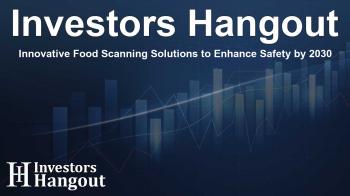Innovative Food Scanning Solutions to Enhance Safety by 2030

Growth of Food Scanning Technology Market
The global food scanning technology market is evolving rapidly, focusing on ensuring safety, quality, and transparency in food production and distribution. Recent estimates indicate that by 2030, the market could reach an impressive $2.16 billion, representing a substantial growth rate. This burgeoning industry is underpinned by increasing consumer awareness and stricter regulatory measures.
Drivers of Market Expansion
Food producers, retailers, and regulatory bodies are prioritizing safety and quality assurance, propelling the demand for food scanning technologies. The quest for transparency, especially among health-conscious consumers, has spurred retailers to invest in tools that can verify food authenticity and safety. By integrating innovative technologies, stakeholders aim to enhance public trust and product integrity.
Technological Advances
Advancements in software have transformed food scanning technology, enabling real-time data processing and improved decision-making capabilities. These software platforms facilitate seamless interactions between scanning devices and centralized monitoring systems, thus enhancing product traceability and compliance with safety standards. Furthermore, new algorithms enable the detection of potential food contaminants, which is crucial for maintaining the quality of food services.
Role of Scanning Devices
Scanning devices are pivotal in this ecosystem, providing essential tools for real-time inspection of food safety, authenticity, and nutritional value. With an increased demand for portable and non-invasive technologies, these devices are being utilized more widely in food processing plants and retail outlets. Technological innovations such as hyperspectral imaging and biosensors are leading to precise detection of various quality indicators.
Impact on Food Testing Laboratories
Food testing laboratories are at the forefront of driving the uptake of food scanning technologies. These facilities utilize advanced scanning systems to ensure food safety and regulatory compliance. As concerns about food adulteration and safety grow, laboratories require high-throughput, efficient scanning capabilities to handle extensive sample volumes. Collaborations with producers ensure that products meet rigorous safety standards.
Ensuring Food Safety and Consumer Awareness
Rising consumer expectations regarding food safety and clarity in product labeling have led to an increased reliance on food scanning technologies. With the demand for transparent sourcing and ingredient validation, brands that effectively utilize scanning data stand to gain a competitive edge. The push for clarity in food content will likely continue influencing market dynamics.
Current Trends and Future Projections
The food scanning technology market is marked by several emerging trends. The growth of online food delivery services and the demand for ready-to-eat products necessitate rigorous quality checks. Scanning technologies assist retailers in ensuring that their products maintain the expected freshness throughout their shelf life. As e-commerce expands, so does the need for standardized quality across inventories.
Functional Foods and New Market Dynamics
The increasing consumer inclination towards functional foods has opened new avenues for food scanning technologies. Products incorporating active compounds require precise measurement and validation. Scanning technologies can assist manufacturers in ensuring formulations meet consumer expectations, while also providing scientific validation for nutritional claims.
Conclusion and Future Outlook
As food safety concerns, consumer demands, and regulatory requirements intensify, the food scanning technology market is poised for significant growth. Stakeholders across the food supply chain are increasingly recognizing the value these technologies provide in ensuring product integrity and consumer trust. As the industry adapts to meet evolving challenges, the integration of innovative scanning solutions will play a crucial role in shaping the future of food production and distribution.
Frequently Asked Questions
What is the forecasted growth of the food scanning technology market?
The market is expected to reach $2.16 billion by 2030, exhibiting a 7.3% annual growth rate.
Why is the demand for food scanning technology increasing?
The demand is rising due to increased consumer awareness regarding food safety, authenticity, and the need for regulatory compliance.
What role do software solutions play in food scanning?
Software enhances data processing capabilities, allowing for real-time decision-making and better integration with scanning devices.
How are food testing laboratories influencing the market?
Food testing labs are adopting advanced scanning technologies to validate food safety and nutritional claims, thereby driving market growth.
What is the significance of scanning devices in the food supply chain?
Scanning devices are essential for ensuring real-time inspection, improving food safety, and maintaining accurate inventories within processing facilities.
About The Author
Contact Henry Turner privately here. Or send an email with ATTN: Henry Turner as the subject to contact@investorshangout.com.
About Investors Hangout
Investors Hangout is a leading online stock forum for financial discussion and learning, offering a wide range of free tools and resources. It draws in traders of all levels, who exchange market knowledge, investigate trading tactics, and keep an eye on industry developments in real time. Featuring financial articles, stock message boards, quotes, charts, company profiles, and live news updates. Through cooperative learning and a wealth of informational resources, it helps users from novices creating their first portfolios to experts honing their techniques. Join Investors Hangout today: https://investorshangout.com/
The content of this article is based on factual, publicly available information and does not represent legal, financial, or investment advice. Investors Hangout does not offer financial advice, and the author is not a licensed financial advisor. Consult a qualified advisor before making any financial or investment decisions based on this article. This article should not be considered advice to purchase, sell, or hold any securities or other investments. If any of the material provided here is inaccurate, please contact us for corrections.

